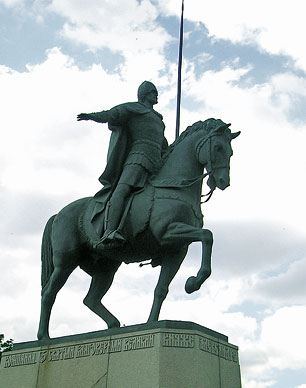ROUTE No. 8
SOUTHEASTERN END OF NEVSKIY PROSPECT: ALEXANDER NEVSKIY SQUARE – STATUE OF ALEXANDER NEVSKIY – ALEXANDER NEVSKIY LAVRA
 At the southeastern end of Nevskiy Prospect lies Alexander Nevskiy Square [1]. One of its focal points is a seven-floor building of the Moscow Hotel [2], constructed in 1974-1977. The hotel overlooks Alexander Nevskiy Bridge [3] – the longest bridge in St. Petersburg (96 meters long), linking Alexander Nevskiy Square with Malaya Okhta district.
At the southeastern end of Nevskiy Prospect lies Alexander Nevskiy Square [1]. One of its focal points is a seven-floor building of the Moscow Hotel [2], constructed in 1974-1977. The hotel overlooks Alexander Nevskiy Bridge [3] – the longest bridge in St. Petersburg (96 meters long), linking Alexander Nevskiy Square with Malaya Okhta district.
In the center of the square stands an equestrian Statue of Alexander Nevskiy [4]. The bronze figure installed on a five-meter pedestal of red granite, was designed by sculptors Valentin Kozenyuk and Albert Charkin. It was unveiled on May 9, 2003 to mark the tercentennial anniversary of St. Petersburg. Alexander Nevskiy (1220-1263) was the Grand Duke of Vladimir-Suzdal and Novgorod during some of the most trying times in the country’s history. He earned his sobriquet by his victory in 1240 over the Swedes on the Neva River. He successfully defended Russia against its western neighbors by defeating the Livonian Brothers of the Sword (1242) on the ice of Chudskoe Lake. Alexander Nevskiy was made a national hero and canonized by the Russian Orthodox Church.
At the opposite side of the square lies the Alexander Nevskiy Lavra [5] – one of the largest architectural ensembles in St. Petersburg. It is located between Alexander Nevskiy Square and Obvodnyy Canal, at the confluence of Monastyrka River and Neva River. The monastery was founded by Peter the Great, on what was once believed to be the site of the battle in which Prince Alexander Nevskiy defeated the Swedes. In 1713-1714 the first wooden Annunciation Church was put up on the left bank of the Monastyrka River, and in 1717 the construction of the monastery started. Peter I assigned utmost importance to the monastery. It became the center of training priests of high rank for the most important Orthodox Churches in Russia. In 1797 the monastery got the Lavra status, which was the highest status of the Orthodox monastery.
The main entrance to the Alexander Nevskiy Lavra is embellished by a graceful Gate Church [6], designed by architect Ivan Starov in 1783-1785, and beyond it there are several graveyards. To the left of the main entrance lies the 18th-century Lazarus Cemetery [7], the oldest in the city. It was inaugurated soon after the foundation of the monastery in 1716 when Natalya Alekseevna, the much-loved sister of Peter the Great, was buried here. Many eminent figures in Russian culture, such as scholar Mikhail Lomonosov and architects Andrey Voronikhin, Adreyan Zakharov, Giacomo Quarenghi, Carlo Rossi and Ivan Starov lie at rest here.
To the right of the main entrance you will see the Tikhvin Cemetery [8]. Here on the gravestones you will find the names of composers Mikhail Glinka, Pyotr Tchaikovsky, Modest Mussorgsky, Nikolay Rimsky-Korsakov, writer Fyodor Dostoevsky, fabulist Ivan Krylov, architect Vasiliy Stasov, sculptor Pyotr Klodt and other prominent figures in science and the arts.
Architects Domenico Trezzini and Ivan Starov assisted in building the monastery. Its oldest part is the tower to the left of the main gate. In this two-storey building there are two churches: the Upper church erected in honor of Alexander Nevskiy, and the Lower one – the Church of the Annunciation [9]. Among the stone slabs of the church a marble gravestone is immured bearing the laconic inscription (believed to have been at the request of the Generallissimo himself): “Here lies Suvorov”. Many other burial places in this church have gravestones sculptured by Ivan Martos, Fyodor Gordeev and other outstanding Russian masters. Today the Church of the Annunciation contains a collection belonging to the Museum of Urban Sculpture. Among items on display are models of a variety of different monuments and statues of St. Petersburg.
The compositional center of the Alexander Nevskiy Lavra is the Holy Trinity Cathedral [10], built in 1776-1790 according to the plan of architect Ivan Starov. The cathedral was consecrated in the name of the Holy Trinity on August 30, 1790 in the presence of Empress Catherine II. On the same day the silver shrine with the holy remains of St. Alexander Nevskiy was moved to the cathedral.
The monumental shapes of the Holy Trinity Cathedral harmonically fit the buildings of the monastery. The exterior is dominated by the dome mounted high on a drum and the two square bell towers; the entrance is framed by a six-columned portico. The interior, designed in the form of a Latin cross, is very spacious. The wide nave, flanked by Corinthian columns with gilded capitals and statues of saints, leads to the gorgeous marble iconostasis. The splendid frescoes of the vaults and dome were made according to Giacomo Quarenghi design and date from 1806.
The building to the right of the cathedral is the Fedorovskiy Wing [11], built in the 1740s by Pietro Antonio Trezzini, the son of Domenico Trezzini. The other buildings, proceeding clockwise around the central square of the monastery, are the Seminary Wing [12], the Metropolitan’s House [13], and – back opposite the Church of the Annunciation – the Prosfornyy Wing [14]. All these buildings were erected between 1756 and 1771 to the design of Mikhail Rostorguev.
Behind the Holy Trinity Cathedral lies the Nicholas Cemetery [15], founded in 1863. Many famous people are buried here.
